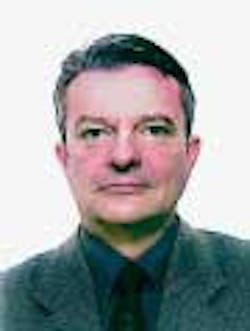Comments from Offshore's 2001-2002 Editorial Advisory Board
Ultra-deepwater E&P challenges ahead
When the giant fields Marlim, Auger, and Mars were discovered in 1985, 1987, and 1989, respectively, a rush toward deep offshore acreage was expected. However, that rush did not take place for nearly a decade. Deep offshore exploration was taken seriously only when it became obvious that the well productivity on Auger was far above expectations.
This delay can be explained by the fact that the geological concept upon which deep offshore exploration was based, although not completely new, was not well understood. Part of the problem was the non-existence of outcrop analogues at the right scale. The development of 3D seismic resulted in a much better definition of the geometry of the reservoirs. The now-common images of wide, large, sand-rich meandering channels were a surprise for many.
Major discoveries such as those in Block 17 offshore Angola from 1996, as well as high productivity from unconsolidated reservoirs, conjugated with improved surface technology, led to a general recognition of the potential in deep offshore areas.
Exploration and production in ultra-deepwater will obviously require that technology be adapted to the deeper environment. A mere improvement of existing technology may prove to be insufficient, but that will depend on the geographical location of reserves and technological problems not faced previously by operators. Experts seem to agree that technology will be asked to provide appropriate answers in six major domains:
Seismic
It is believed that 4C seismic, seismic while drilling, and 4D seismic have a strong potential to avoid costly hazards and to reduce risks associated with ultra-deep water exploration and production.
Multi-component (4C) seismic is becoming an indispensable tool in specific conditions such as prospects under salt domes or basalt and for imaging beneath gas accumulations. In addition, 4C-seismic surveys contribute to the discrimination between lithology and fluid content to assist reservoir evaluation work.
At the exploration stage, drill bit seismic and seismic measurements while drilling could be used to calibrate models and locate the bit on seismic surface sections. Extending these techniques to deepwater could help to place casing points and monitor over-pressured zones, for example. During production, detailed quantitative analysis of time-lapse seismic (4D) could be used for reservoir monitoring purposes, especially to identify areas that may contain bypassed reserves.
Earth modeling
The information from high quality seismic must be incorporated into 3D reservoir models that will be used to predict production rates under various development scenarios. This is achieved through the use of "earth modeling" tools whereby information derived from well data, 3D seismic, and geological knowledge can be captured in an appropriate fashion.
These cross-disciplinary tools are now often used for reservoir characterization studies performed on deep offshore fields. However, a very delicate upscaling phase is required to translate the geological earth model into a dynamic reservoir model, out of which flow simulations can be carried out.
Drilling
For more than 15 years, it has become clear that the drilling riser was a critical element. The riser had to be made lighter to avoid excessive tension. This is being achieved by replacing steel with titanium or composite materials. Kill and choke lines can also be improved by using composites or hoop-wound steel lines. Both solutions must still be qualified, economically and technically.
One of the greatest challenges is the range of temperatures and pressures encountered while conducting ultra-deepwater drilling activity - from almost 0°C at the seabed to 150°C in the formation, and up to 400 bars at the mud line. Efficiency and safety of drilling operations at great water depths require the availability of drilling fluids suitable for these extreme conditions, mainly to prevent anomalous pressure losses in the well, plugging of kill and choke lines caused by gelling, or hydrate formation in the drilling fluid.
The risk of a blowout during drilling is not yet totally eradicated because of possible overpressure in certain formations. The new technology of 'dual gradient drilling' allows mud to be pumped up to the surface through a dedicated riser. As a consequence, the formation reacts as if the rig were sitting on the seabed, thus providing more operating margin to compensate for a possible kick, by increasing the mud weight.
Production systems
Due to their length and inertia, the seafloor-to-surface links (mooring systems, umbilicals, and risers) can cause non-linear dynamic interactions with the floating support to which they are attached. They are also subject to vortex shedding, leading to vortex induced vibrations (VIV) capable of inducing fatigue failures.
For the drilling riser, the weight of these links must be reduced. This constitutes a major objective for development operations in 3,000 meter water depths. Titanium may be considered for risers. Synthetic materials such as polyester, high modulus polyethylene, or aramid is being considered for mooring lines, composite risers, and tension leg platform (TLP) tethers. New concepts (steel catenary risers, hybrid risers towers, bundled hybrid risers, and others) have been proposed, all attempts to provide an answer to the problems posed by external hydrostatic pressure and large top tensions.
Floating supports
Drillships are emerging as the best solution for ultra-deepwater drilling. The vessels' size recently increased, which has led to a substantial improvement in hydrodynamic behavior and made them capable of supporting the riser and associated equipment. It is now anticipated that it will be cost effective to drill, perform well maintenance, and produce from the same infrastructure.
New concepts of floating, production, drilling, storage and offloading vessels (FDPSOs), replacing FPSOs (without drilling), coupled with conventional subsea architecture, are promising. Combined with subsea completions placed below the vessel, this type of unit will allow full-field development and operation from a single vessel support, providing the reservoir shape and characteristics are adequate.
Flow assurance
Conditions prevailing at the seabed are prone to hydrate formation and/or wax deposition at the pipe wall. Therefore, it will be critical to qualify high-performance insulating materials capable of withstanding large static pressures. Different innovative options are under development, such as high performance foams, new polymer blends, and materials releasing heat during a phase transition.
Re-start conditions after shutdown are not very well known. A lot of work is still necessary to provide meaningful modeling tools, scenarios for additives injection (including low dosage), inert fluid circulation, or controlled blow-down. Another solution to hydrate-related problems consists of water knock-out at the wellhead. Several projects are under investigation, but it will take time before actual implementation.
Multiphase transport modeling tools must be improved to better suit newer domains of operation. These tools must be capable of predicting flow regimes in risers where static pressures may decrease by 200 bar between bottom and top, and also provide more accurate prediction of temperature profiles along the flow lines, taking account the interaction with the seabed and the conduction/convection phenomena within the insulating materials.
There are many other disciplines central to the development of deepwater and ultra-deepwater - geotechnics and meteocean, for example - and the list can go on almost indefinitely. What remains true in the end is that the development of ultra-deepwater will become progressively driven by increasingly sophisticated techniques. It will necessitate a growing measure of science, competencies, technical expertise, and cutting edge technologies that will affect - in a profitable way - all the fields of relevant activities.
Alain Delaytermoz is the R&D Program Manager for TotalFinaElf. He holds chemistry and technology degrees from Ecole National Superieure des Industries du Genie Chimique and Ecole National Superieure du Petrole et des Moteurs. He joined Total in 1980 as a process engineer and has worked in various technical management capacities.
Alain Delaytermoz of TotalFinaElf, Mike Harris of Apache Corporation, and Dr. B.P. Malcolm Sharples of ABS Offshore are members of Offshore Magazine's 2001-2002 Editorial Advisory Board. Their comments on the following pages are some of the major concerns in their respective industry sectors. Due to time constraints, other board member comments, including those of Robert Campbell of Noble Drilling, Steve Ludlow of Veritas DGC, Doug Rock of Smith International, and Lars Felix of GVA Consultants, could not be included.



